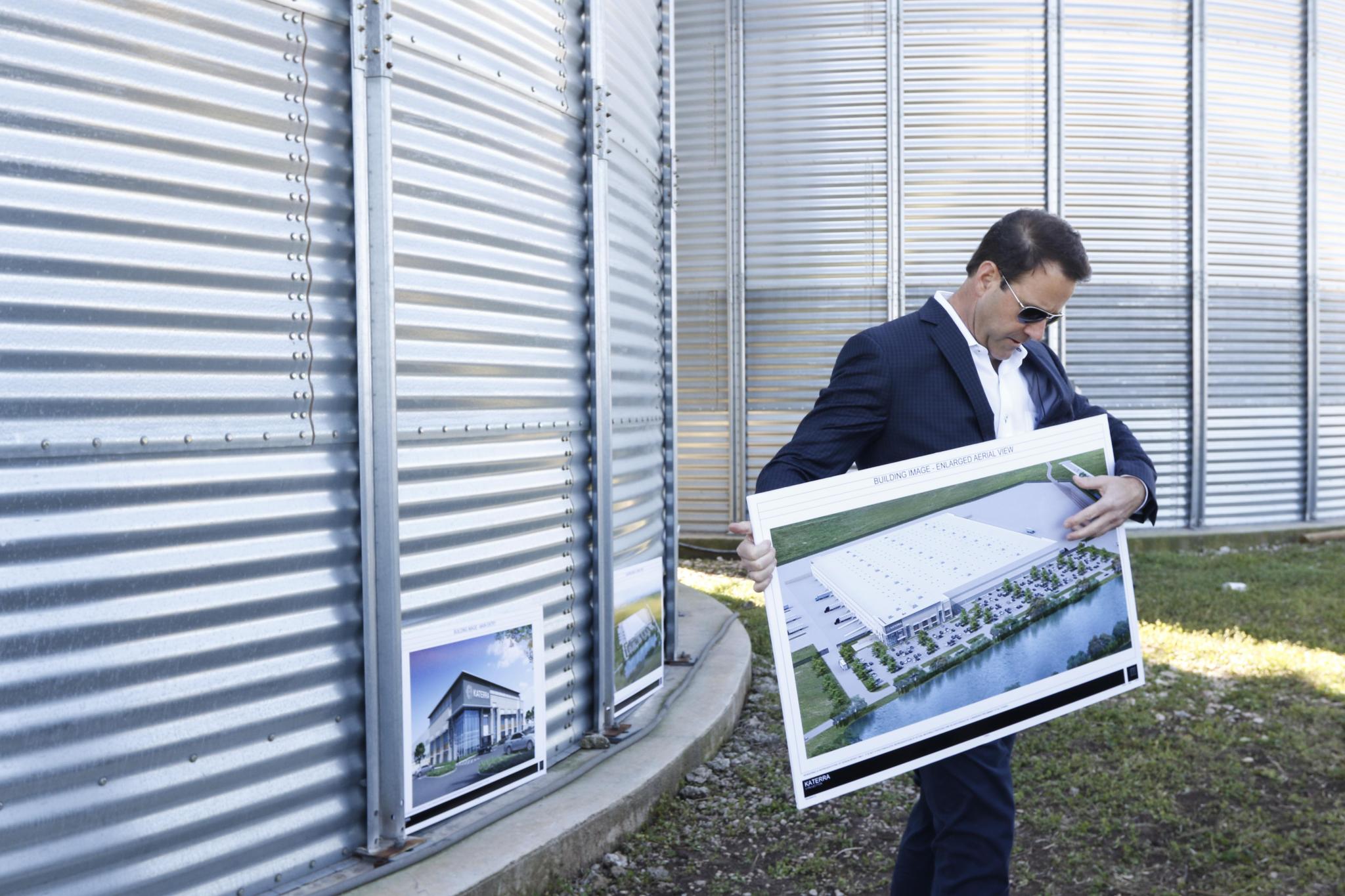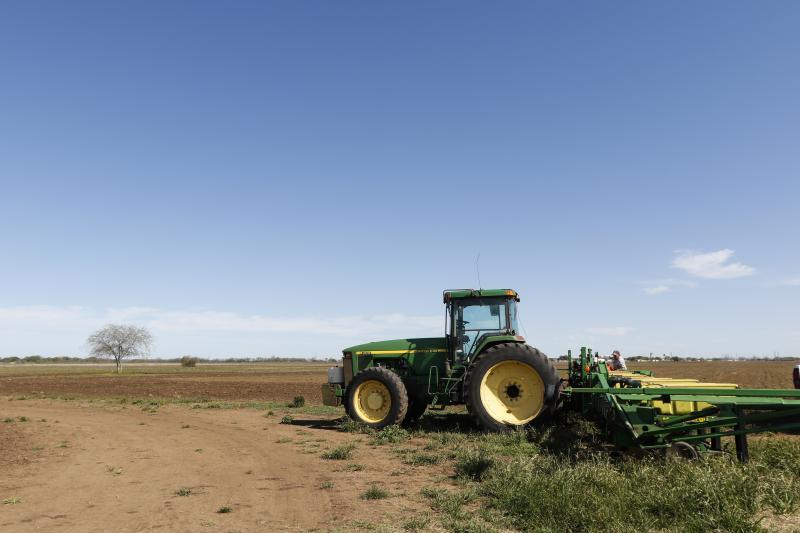
With grain silos as a backdrop, developer Michael Schroeder explains an architect’s rendering of the Katerra building, which is slated to become the first tenant in the SMART Terminal. The project goes up for an annexation vote Tuesday before the San Marcos City Council. Daily Record photos by Denise Cathey
Media tours proposed site
The proposed SMART (San Marcos Air, Rail and Truck) Terminal development east of town will include measures to improve water quality and abate flooding, the project developer and engineer said Thursday.
Developer Michael Schroeder, engineer Jim Welch and Greater San Marcos Partnership Marketing and Communications Director John Ellis led media representatives on a brief tour of the development site — specifically, the portion of the 934-acre parcel where Katerra will build a manufacturing facility. Katerra, a construction firm based in California, has an economic development agreement with the city of San Marcos and will be the first SMART Terminal customer if the development is approved. Welch is the engineer working on the Katerra project.
“I really admire the confluence of all the logistics here,” Schroeder said. The site, which currently consists of windswept farmland, lies along State Highway 80 and Farm to Market Road 1984. The location is bordered by a rail line, adjacent to Gary Job Corps and the San Marcos Regional Airport, and right along where Farm to Market Road 110 is slated to go.
Recently, an organized group of residents called SMARTER San Marcos has spoken out against the terminal, citing its size and proximity to the river. SMARTER San Marcos and other concerned parties have said the edge of the development is too close to the San Marcos River — distances vary from about 1,200 feet to 1,420 feet — but Welch said that Katerra will be located about 3,700 to 4,000 feet from the river’s edge. Schroeder said Katerra will be the closest the development gets to State Highway 80, which lies between the SMART Terminal property and the river.
Focusing on the Katerra development, Schroeder said that Katerra will bring close to 550 jobs to the area and hopes to have low worker turnover.
“They’re very employee-centric,” he said of Katerra, noting that the lowest paying jobs the company will bring to the area pay about $36,000 per year.
“The leaders of this community are trying to make this an attractive place for attractive employers,” Schroeder said.
As for the broader SMART Terminal development, Schroeder said the rail line will have service from Union Pacific and BNSF, the top two rail service providers in the country. The proposed terminal would have six tracks able to accommodate four trains off the main line.
“It has the ability to support several companies like the Katerra company,” he said.
Ellis emphasized the economic opportunity the SMART Terminal represents for San Marcos and Caldwell County.
“The SMART Terminal is a unique opportunity in the region,” he said, noting that the development could bring unprecedented economic growth and a minimum of 2,500 jobs.
Schroeder said he wants the city of San Marcos to annex the property so that the city’s new development code will guide construction, land use and business practices at the project. The city’s new code addresses issues including stormwater drainage and water quality, and prohibits any new development from raising water levels or otherwise worsening flooding for its neighbors. Schroeder emphasized his desire to make the SMART Terminal successful not only economically, but in terms of neighborhoods and the environment.
“I’ve been in the San Marcos River probably three dozen times,” he said. “... We have those same values as people concerned about the river have.”
To mitigate flooding — Schroeder said that right now, the site receives runoff from the airport, which has no stormwater mitigation measures in place — the SMART Terminal development will have a detention pond on the south side of the Katerra site. Welch explained that the pond will catch the first 1.5 inches of rain that falls on the development site and hold it, allowing suspended solids to filter out and slowing the flow of water downhill.
“With your development agreement, there’s specific codes we agree to,” Welch explained. He added that right now, the property consists largely of plowed farmland, where the dirt is loose and can be carried downhill when it rains. However, once development starts, the Texas Commission on Environmental Quality has erosion control standards that must be followed.
Welch also said that drainage improvements that will accompany FM 110 and other drainage control measures in the works will provide a “very favorable combination” in the future.
Schroeder mentioned that the amount of impervious cover in the proposed SMART Terminal will be less than the maximum allowed, and that there will be water filtration measures put in place that are not required.

A tractor in an unplanted field. In the distance are the San Marcos Regional Airport and the Gary Job Corps Center.
Karen Ford from the SMARTER San Marcos group, who was also on the tour of the development site, asked what would happen if we received 5 inches of rain instead of 1.5. Welch said that the TCEQ standard for detention is to capture the first 1.25 inches — the “first flush” that often carries suspended solids — but that city engineers had been working with project engineers on flood mitigation. Welch said the project will “adhere to code, at the minimum.”
Caldwell County Judge Hoppy Hayden was present and said that the Caldwell County Commissioners Court has passed resolutions supporting the SMART Terminal.
“We recognize there are some issues I feel are being addressed,” he said, adding that the opportunity for Caldwell County residents to be able to find jobs without a long commute is “very attractive.”
Schroeder said the terminal is likely to start off with three or four customers but that use of the terminal is a “customer-driven” matter.
That said, Schroeder noted, “San Marcos is a very desirable place,” and for companies looking to ship or receive materials over long distances, “They’re going to be looking for the rail.”
Schroeder said that he appreciates SMARTER San Marcos and their concern for and focus on the river, which has brought environmental concerns to the fore.
“I think it’ll end up making this a better project,” he said. “I’m always interested in ways to make it better.”











